Who could ever forget the catchy phrase “I don’t want to grow up, I’m a Toys R Us kid” from the famous commercial that dominated home televisions? Who didn’t fall in love with Geoffrey the Giraffe, the store’s brand mascot? Who would have ever thought that the day would come when that phrase would be just that—a phrase? There’s no establishment to speak of anymore. No more stores in the U.S. No more business. All that’s left is a load of memories and experiences once shared by the toy retailer with its loyal customers.
Toys R Us was one of those American success stories. It had its beginnings as a baby furniture shop called Children’s Bargain Town in 1948 in Washington, D.C. It later established itself as a global retailer of toys, baby stuff, educational materials, children’s clothing, and other products at the lowest prices. The founder, Charles Lazarus, eventually decided to name the store Toys R Us in 1957 after its major expansion into toys. With the vision of putting joy in the hearts of kids and painting a smile on the parents’ faces, Toys R Us indeed made lots of children and parents happy with the products they offered. They also proved it was not just about business as they made huge donations to various local charities through their Global Resource Center.
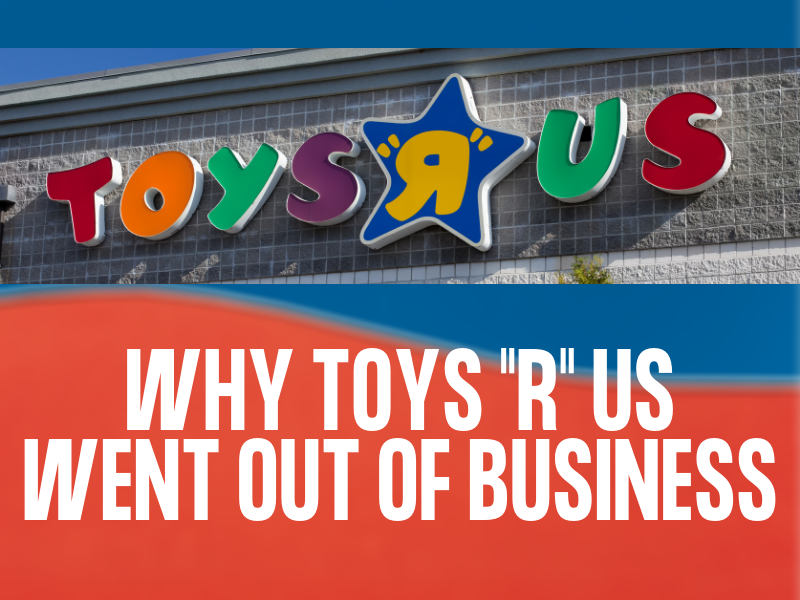
Use these page jumps to find out Why Toys R Us Went Out of Business:
The Days of Glory
The Fall from Glory
Reasons for the Closure
* Debt
* Competition
* Management
* Consumer Trend
* Store Presentation
* Customer Service
* Innovation
* Shopping Experience
Toys R Us Comeback

The Days of Glory
In 1978, Toys R Us started trading as a public company in the New York Stock Exchange. It became one of Wall Street’s hottest stocks. It then started expanding to various categories in the retail market. First, it delved into clothing, which became known as Kids R Us and first opened in 1983. Babies R Us happened in 1996. Kids R Us and Babies R Us helped bring profit to the company all year round, considering that toys are typically associated with a seasonal hype.
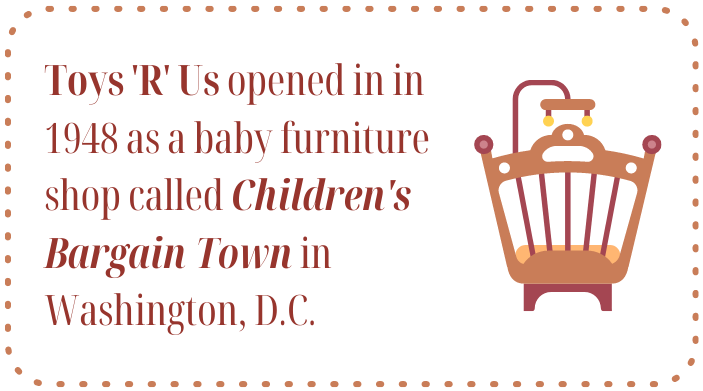
In 2001, it opened what was dubbed as the world’s largest toy store. It was their flagship store, which was located in the heart of Manhattan at Times Square. It boasted a Ferris wheel the height of a three-story building, a 20-foot high T-Rex controlled by electromechanical devices, a giant LEGO-made Empire State Building, and a life-size Barbie dollhouse. Toys R Us went on to purchase a 190-acre parcel of land in 2001 that served as its new headquarters.
Toys R Us, as founder Lazarus described it, was a supermarket for toys, and it had no competitors in the field up to the ’80s! Under new management following a leveraged buyout deal in 2005, Toys R Us bought other toy companies such as K.B. Toys, Etoys.com, FAO Schwarz, and Toys.com. Its registration for initial public offering (IPO) began in May 2010.
Toys R Us was named one of America’s Largest Private Companies in 2017, placing 22nd in the Forbes list with a revenue of $11.5 billion—2.2% lower than the previous year. Yet, they still managed to come out on top.

The Fall from Glory
Toys R Us stood strong until newcomers introduced changes in toy trends and customer preference. Over a 10-year period, the company struggled with steep revenue declines. They filed for Chapter 11 bankruptcy in September 2017, and revealed plans to liquidate the business.
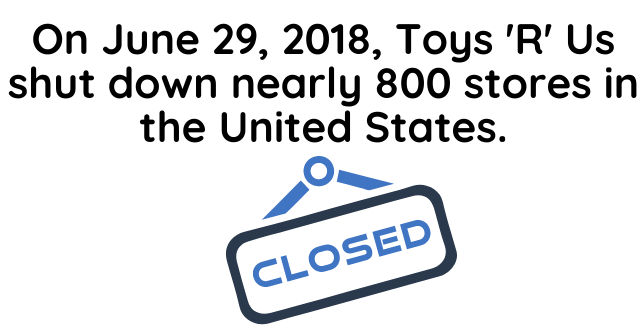
However, Toys R Us isn’t new to bankruptcies. In 1966, it was sold to Interstate Sales and later filed for bankruptcy in 1974. After a restructuring, the company bounced back in business once again and emerged as the top toy seller.
For the first time in 1988, Toys R Us was defeated as the top toy retail store in the United States by Walmart, which offered way lower prices. Then there was the closing of Kids R Us stores in 2003.
The company became private again in 2005 after a leveraged buyout deal by Bain Capital, Kohlberg Kravis Roberts, and Vornado Realty Trust for almost $7 billion.
In 2012, their EBITDA already failed to meet half of its earnings from its previous years of operation. Their on-going registration for initial public offering had to be withdrawn due to declining sales and other factors affecting the IPO market. Due to rising rentals, it was also constricted to close down its great flagship store in Times Square and its acquired FAO Schwarz store located at Fifth Avenue.
Toys R Us had difficulty in improving their revenue and has struggled with all the debts it has acquired for the past years. They began disappearing from lists of top companies from different surveys and studies. They sought the help of a law firm in 2017 for the restructuring of the company with the hope of saving it from closure. This has however failed and as a consequence of the build-up of years of debt, mismanagement, and other factors, the Toys R Us, the leading toy store company in the United States, has finally bid goodbye to the millions of its customers who have shared their childhood with them. In their final farewell message, they played with the lines from their famous jingle and turned it into “Don’t ever grow up. Play on!” with words of gratitude for their loyal customers through the decades of its existence.
On June 29, 2018, Toys R Us shut down nearly 800 stores in the United States.

Reasons for the Closure
Toys R Us was around for seven decades and dominated the toys and baby stuff scene. It was once an iconic company with a success story to tell. But all that started to dwindle down in the early 2000s. The overwhelming debt along with other factors made it difficult for the company to rise up from the rubble.
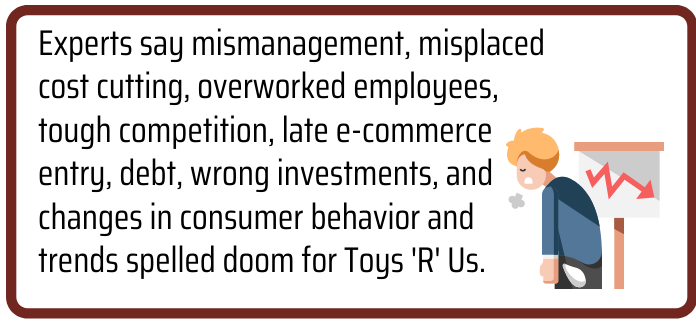
Even the different holiday sales, which spiked up their revenue in the past, failed them in their last few years in the industry. All the more reason that the management lost hope that they would be able to recover from the mountains of debt they had incurred trying to save the company. The untimely filing for bankruptcy affected their holiday sales because loyal customers thought twice about purchasing gift cards from them considering the impending closure of its stores in the United States plus the fear of unaccepted returns.
There were a lot of factors that affected its performance in the market which eventually led to its downfall. Mismanagement, misplaced cost cutting, overworked employees, strong competitions in the industry, late e-commerce entry, debts, low prices, wasted potentials, wrong investments, and changes in consumer behavior and trends eventually led the business to its demise. Let’s take a look how these factors took down a big giant of the toy industry.
Debt
Toys R Us was already billions in debt and the revenues earned were automatically directed to paying the interests acquired by this massive debt. It is safe to assume that this is when the problems of the company started to pile up.
Since money was scarce, appropriate investments for the stores and employees were put off in order to pay off the growing debt first. This meant that they would be unable to keep up with the competition since the latter were introducing new changes in the field while they were stuck with their same old strategy.
Competition
It was not enough that the company was earning and making profitable investments, it was a must for Toys R Us to step up their game in a field full of competitors. Competitors who were really serious in the business heard of the impending closure of their major competition in the industry. They took a dive and offered rare high discounts during the holiday season before its closure.
Since other retailers such as Target, Amazon, and Walmart came in the field, competition in prices became so intense that Toys R Us failed to keep up with the low prices these retailers offered for the same products. Aside from price competition, these other players in the field also developed their own products and brand. These are products that are exclusively sold by them and could not be found in any other retail stores.
What Toys R Us was selling was products with brands that are also sold elsewhere, both online and in brick and mortar shops, and sometimes with a much better offer. This was one of the reasons why people stopped visiting and purchasing from Toys R Us stores. What they offer is also offered by other companies with much more convenience and amazing deals.
Management
According to Mark Cohen, a director at Columbia University’s Graduate School of Business specializing in retail studies, the internationally well-known toy store chain was guilty of serial mismanagement.
The years of changing CEOs and the never-ending introduction of structural changes have greatly affected the performance of the company as there was no coherent and consistent plan and mode of action when it comes to dealing with the business. The approach to the problems posed by the changing marketplace, consumer behavior, and internal issues was not systematic and organized. Every time there was a change in management, the on-going resolution of the present problems at the time was altered and the process had to restart again. The solutions set were not given enough time to actually solve their problems. The new management was always eager to try a different approach instead of working with the present methods, taking risks with great consequences.
What Toys R Us failed to acknowledge and address was what was within their own backyard, their own employees, and their own talents. They focused so much on outsourcing and external management hires that they forgot to look into internal potentials. The people who know the business well enough are the employees themselves who witnessed every rise and fall of the company. These are the people who have the potential to pinpoint and address the key points in solving the actual problems even in just the frontline area. The management could have invested in that aspect and in their employees by providing educational tools, assessing the needed roles, monitoring, and tracking progress, and preparing for what the future holds for their employees and their company. Instead, they under-invested in them and preferred outsiders to solve internal matters.
The more recent managements didn’t take care of its employees unlike three decades ago when they were provided with health benefits and offered options to purchase stock from the company. There were steps taken to improve and develop the skills of their employees. Prior to its closure, part-time workers with minimum wage were preferred over experienced employees. The neglect of the employees resulted to the latter not caring much for the company. They were just in it for the job. Unhappy employees do not make happy customers.
Consumer Trend
The only constant thing in this world is change indeed. Consumer preferences, behavior, and trends change along with time especially in the toy industry which is an extremely trend-sensitive area. Children nowadays prefer iPads, tablets, computers, and other gadgets over best-selling and iconic toys of older days like Barbie Dreamhouse, Stretch Armstrong, Pet Rock, Tickle Me Elmo, Tamagotchi, Cabbage Patch Kids, Easy Bake Oven, Furby, Ty Beanie Babies, Teddy Ruxpin, Super Soakers, NERF guns, and Hot Wheels. Physical and actual toys are just not that appealing to kids these days anymore. The trend has already moved digital resulting to less demand in physical toys.
The problem was Toys R Us kept selling the same products to a different generation of children in a different time, putting the same products over and over again on their shelves. They didn’t bother adjusting to current hype and changes in the marketplace. They stayed and kept with what was on-hand and comfortable with them.
Online video games and other digital platforms are where almost all children spend most of their time. These are very much accessible at home through the internet. They no longer need to go out and go to an actual brick and mortar store to experience them. This should have been an area where Toys R Us focused on, that is, reaching homes without families having the need to leave their doors.
People are also after convenience these days. They want hassle free transactions and as much as possible doorstep delivery. Between going shopping in a big and messy store with a kid about to throw a tantrum anytime and shopping online within the comforts of their home, parents are most likely to prefer the latter after a long week’s work.
Store Presentation
Who would want to spend hours in a store that is uninviting or even just enter it? Shoppers follow what their eyes see and want at the moment. It is but logical that people would go after what is appealing to their eyes.
Toys R Us is already known for its big open-space stores and seemingly unorganized arrangement of its shelves. The store felt like a warehouse and it was difficult to find what you went to the store for in the first place or decide what to buy due to the overwhelming and messy selections. The premises were unwelcoming and people didn’t really feel comfortable staying in long enough to actually purchase something.
To add up to the already unappealing store set up, they also neglected to keep up with the maintenance of their establishments. In the last years before its closure, the company decided to cut costs on cleaning services and let go of other employees. This decision resulted in dusts, dirty floors, lack of experienced employees, and overworked remaining employees who can no longer keep up with the upkeep of the store premises.
This was one of the small factors that had a big impact on the customer pull and revenue of the business.
Another reason for the decline in revenue was the combining of the Toys R Us and Babies R Us under one roof. Although connected in many ways, they served various purposes and targeted different individuals. The Babies R Us was left with little space to work with than it usually had solo. They could no longer deliver to their intended customers the envisioned baby room or nursery the latter has in mind when entering the store.
Customer Service
Due to the continued lay-off of full-time employees and other experienced staff and overloading of work to part-time employees, they could no longer provide efficient and satisfactory customer service. In short, they were understaffed. With so much workload with inventory, shelves arrangement, and store maintenance, employees didn’t have much time and energy to focus on what matters most, keeping the customers happy and satisfied. The place was such a mess that employees themselves could not help customers with what they were looking for at times.
Although toy shopping can be done with little or no help at all from the staff, it is a different experience for everybody altogether. Parents, grandparents, aunts, uncles, and other adults may not have the knowledge or be up-to-date with the latest and in toys that the children might like and appreciate. Other customers may not be knowledgeable as to how to operate a certain toy. Toys and other products might be placed too high in the shelf. Big and small things like these instances matter on a case-to-case basis for every customer.
Innovation
Toys R Us invested in a lot of different things but not on its online and digital presence. Another aspect of technology, aside from online, that they could have taken advantage of was their inventory management system. They were doing poorly in inventorying the piles of toys and other products that went into the store. This led to a delay in information, such as whether products were still available or already out of stock which resulted in many disheartened customers who were looking forward to having the latest toys in their hands.
In these modern times, e-commerce and technology should have been something they have considered early on to widen their scope. Their other competitors in the field like Target, Amazon, and Walmart have been determined from the very beginning to conquer customers through that medium.
When every retail business was going online, Toys R Us remained and solely relied on their brick and mortar set up and defended its online marketing to Amazon without caring to upgrade its website to fit the latest trends that would attract new customers and keep old ones. In 2016, the online purchase of toys went up to 13.7% from 6.5% in 2011.
Their 10-year deal with Amazon, with them at the losing end, greatly contributed to their loss of greater possible income if it developed its online presence alone. An annual fee of $50 million and an additional commission per sale given to Amazon proved to be too much for the toy retailer to handle. They also failed to establish their independent online presence which could have made customers buy more from their store unlike in Amazon where they would be tempted to check out other products from other suppliers or stores.
It entered and upgraded their online presence way too late in the game. Although it has improved its website with a much user-friendly interface, new look, and a faster transaction process, its I.T. system and infrastructure failed to keep up with such upgrade. It had glitches, incomplete and not up-to-date information and crashed which resulted to unsuccessful transactions. These unsuccessful transactions made customers unsatisfied with their experience and shift to other online stores that offer the same products with less hassle.
Their late entry in the online business made it difficult for them to compete equally with other online stores who already have an established pool of customers in the online world. They could no longer adapt with the fast-paced changes made by e-commerce.
In a fast changing world, what it immensely failed to do was to reinvent itself. It failed to innovate how it dealt with business and didn’t take advantage of the great influence of technology and the social media platform.
Shopping Experience
Toys R Us, throughout the years, remained as it was from the time it reached its peak. What attracted customers then, didn’t work in the changing times. It has failed to re-present itself in a fresher and more interactive manner. It has failed to make people excited about coming to their store. It hasn’t built a strong and lasting relationship that will shape loyalty with its customers and the community in general.
The closure of their flagship store in Times Square was a wrong move for the company. It did not only serve as a retail store but also as a tourist attraction at the same time. The stated reason for the closure was high rentals and at the state of the company then, they surely couldn’t have afforded it. That was it. They simply closed their flagship store without thinking about relocating it to a much affordable location. They knew that the flagship store attracted flocks of customers and tourists daily and brought a lot of revenue for the company and yet, they chose not to do anything about it.
The management could have reimagined the way the store appeals to the customers in terms of their experience especially for the kids while shopping in the store. A more interactive and bringing-the-community-together atmosphere would have attracted more customers to frequent and shop more often. The goal was to make the place irresistible for kids and parents alike that they could spend the whole day on the premises and at the same time spend money willingly on the experience and products because they are worth it. They could have done what other stores were doing like putting up freedom walls, game zones, role-playing areas, movie screens, placing create-your-own booths in the store premises, toy demonstrations, event rooms, and expanding to other locations like malls, pop up stores, and even in cruise ships.
It must put in mind that other customers don’t just visit a store to simply buy and go. Some also visit looking for a different experience and interaction. They are searching for the X factor, something that would make their experience with every store they visit unique. The only store that offered that experience for their customers was their flagship store and when that closed, all they were left with were locations with shelves filled with stocks up to the brim that made it look and feel like a warehouse instead of a magical toy store.
The owners and managers were probably stuck in the time when Toys R Us was on the top of its game that they forgot that the industry is also the survival of the fittest. They didn’t adapt to the changes brought about by time and advancement in technology. They have failed to recognize that it is a must to innovate, to improve, and to reach out to the customers.

The Toys R Us Comeback
From the time it filed for bankruptcy, the existing owners seemed to have planned the resurrection of the company. The company didn’t sell or auction off its intellectual property and retained the name Toys R Us, the mascot Geoffrey the Giraffe, and its website.
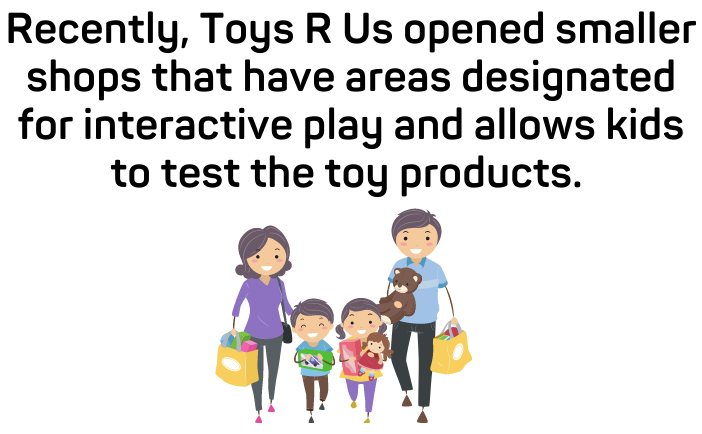
Revamping the company was definitely in the works even after the closure of their stores. The owners continue to develop new ideas to improve the store experience and prioritize the employees.
Through Tru Kids Inc. led by former Toys R Us executive Richard Barry, the Toys R Us website was relaunched in October 2019. The company’s re-emergence is backed by Target and, earlier this year, Amazon.
Despite the unfavorable outcome of a previous Toys R Us and Amazon engagement (that led to a lawsuit), both websites now operate under the Amazon Associate websites. The actual Toys R Us website, meanwhile, now features reviews and videos of the products sold by the retail company.
Recently Toys R Us also opened much smaller experiential brick and mortar stores to test the waters again. The new stores now have areas designated for interactive play, which allows kids to test the toy products. Parents and kids can look forward to an enthralling toy shopping experience again!
By refocusing on important matters, partnering up with the industry’s best, and listening to the dynamic customer landscape, Toys R Us is optimistic about regaining their leadership.